This Singapore Mee Siam Recipe (with Soup) is sweet, spicy, tangy and altogether delicious! No wonder it is such a popular noodle dish in Singapore and Malaysia!

Jump to:
Why Make This
- Mee Siam Kuah is delicious: The gravy is spicy, sweet, tangy and totally mouthwatering, especially with a squeeze of lime juice on the side! (Use calamansi citrus lime if you can get it for better flavor.) (If you don't like soupy noodles, try this stir-fried mee siam goreng (the Malaysian dry version of this dish.)) Enjoy with a cup of OTT Milo Dinosaur!
- It's easy to prep in advance: Most of the work is in cooking the spice paste. You can make a huge batch of the spice paste (rempah) in advance and freeze it for months!
- It's a nutritious, complete meal in itself: served with eggs, beansprouts, seafood and more, you won't need anything else to fill you up! (If you do, here are some Asian side dishes.)
Note: This Singapore mee siam soup recipe is adapted from a vintage Singaporean cookbook by Hong Leong Finance, "Flavours of Singapore" (1994). (I also have a )
For noodle lovers such as myself, here are more Asian noodle recipes.
What is Mee Siam?
Despite its name, Mee Siam is a Singaporean and Malaysian dish, not a Thai one. Having said that, a few people argue that it was influenced by Thai cuisine and call it "siamese noodles.)
In Singapore, we have slightly different Mee Siam recipes, depending on which ethnic group you ask: there's Indian Mee Siam (uses coconut), Malay Mee Siam (Halal) and Peranakan/ Nyonya Mee Siam.
P.S. Peranakan food is 1 of my favourite cuisines- for more Peranakan recipes, check out this vegan kueh dadar recipe which uses freshly squeezed pandan juice.

Ingredients
Some of the key ingredients you will need include:
- Thin Rice Vermicelli (bee hoon): this type of rice noodles soaks up the gravy very well so don't replace it with other random noodles. Tang hoon or glass noodles makes a good substitute, especially for stir-fried dry Malaysian mee goreng, but yellow noodles do not! Bee Hoon is sold dried, and you will need to rehydrate them in hot water (till pliable, about 10-20 minutes) before stir-frying with the rempah spice paste. Don't soak for too long or they'll become brittle.
- Dried Prawns: Dried prawns, also known as hei bi, are often added to give umami to Singaporean and Chinese food.
For the Spice Rempah
- Belacan: Please, please do not substitute belacan fermented shrimp paste with fresh prawns! When I lived in London, I used to participate in the Borough Market Cookbook Club. At the Sybil Kapoor cookbook meeting, somebody kindly decided to make the laksa recipe: however, as she didn't have belacan, she decided to use more fresh prawns. Without the complexity added by the fermented shrimps, the resulting dish tasted flat. (You could try mixing with fish sauce to give it more depth, but I've never tried.)
- Shallots: If you can't get these, onions work as well. Red onions are the best as they're also sweet. If you use yellow or white onions, you may want to increase the amount of sugar slightly.
- Dried chilies: The fresh red chilies are added to give color to the chili paste and the dried chilies for heat. A staple of Malay and Peranakan recipes, they can sting like mad. Use gloves to handle them and NEVER touch your eyes or lips when working with dried chillies! Even the fumes are potent- I once had a burning sensation on my arm for days after stir-frying dried chilli paste. Also remember to remove the seeds, if not, your spice paste will be SUPER hot!
- Candlenuts: If you can't get candle nuts, also known as Buah Keras or Kemiri, which serves as a thickening agent, try ground peanuts or 1 of these easy-to-find candlenut replacements. Do note that candlenuts shouldn't be eaten raw as they are toxic uncooked! I've also made this Nyonya dish without any thickener at all and it was still delicious.
For the gravy
- Tamarind: Also known as assam jawa, this gives the noodles its tangy flavor. You can use tamarind paste or tamarind pulp and mix with water to make the tamarind juice, which will be added to make the sweet and sour gravy. For plant-based tamarind recipes, click here.
- Taucheo: different brands have different levels of salt so you will need to taste and adjust accordingly. If you can't find them, you can use other Asian preserved soy beans such as miso or doenjang instead. (Sorry, Peranakan Purists- when you've been making Asian food in a little village in Scotland, you get used to making do with what you have!)
Suggested Toppings
There is a lot of flexibility in this mee siam recipe, but some traditional ingredients are:
- hard boiled eggs or egg omelette (cut into thin strips)
- prawns
- bean sprouts
- bok choy
- Chinese chives
- fish cakes (I recommend pan-frying them first)
- Tau Kwa (These tofu puffs absorb the mee siam gravy very well! Substitute with firm tofu if you can't get them.)
- lime wedges
- Not traditional but I usually top mine with fried hei bi (dried shrimps)!
For a full list of ingredients to add to mee siam, please scroll down to the recipe card.
Where to Buy
You can find the ingredients in Asian grocery stores. In London, I got mine from the Chinese and Thai supermarkets in Chinatown.
Step-by-Step Instructions
Preparing the Rempah

- De-seed the chillies then boil till soft. Throw the water.
- Drain and blend the chillies with the shallots, belacan, candlenuts and fresh chilies into a fine paste.
Note: the dried chilies are a pain to pound hence I blitz them instead.
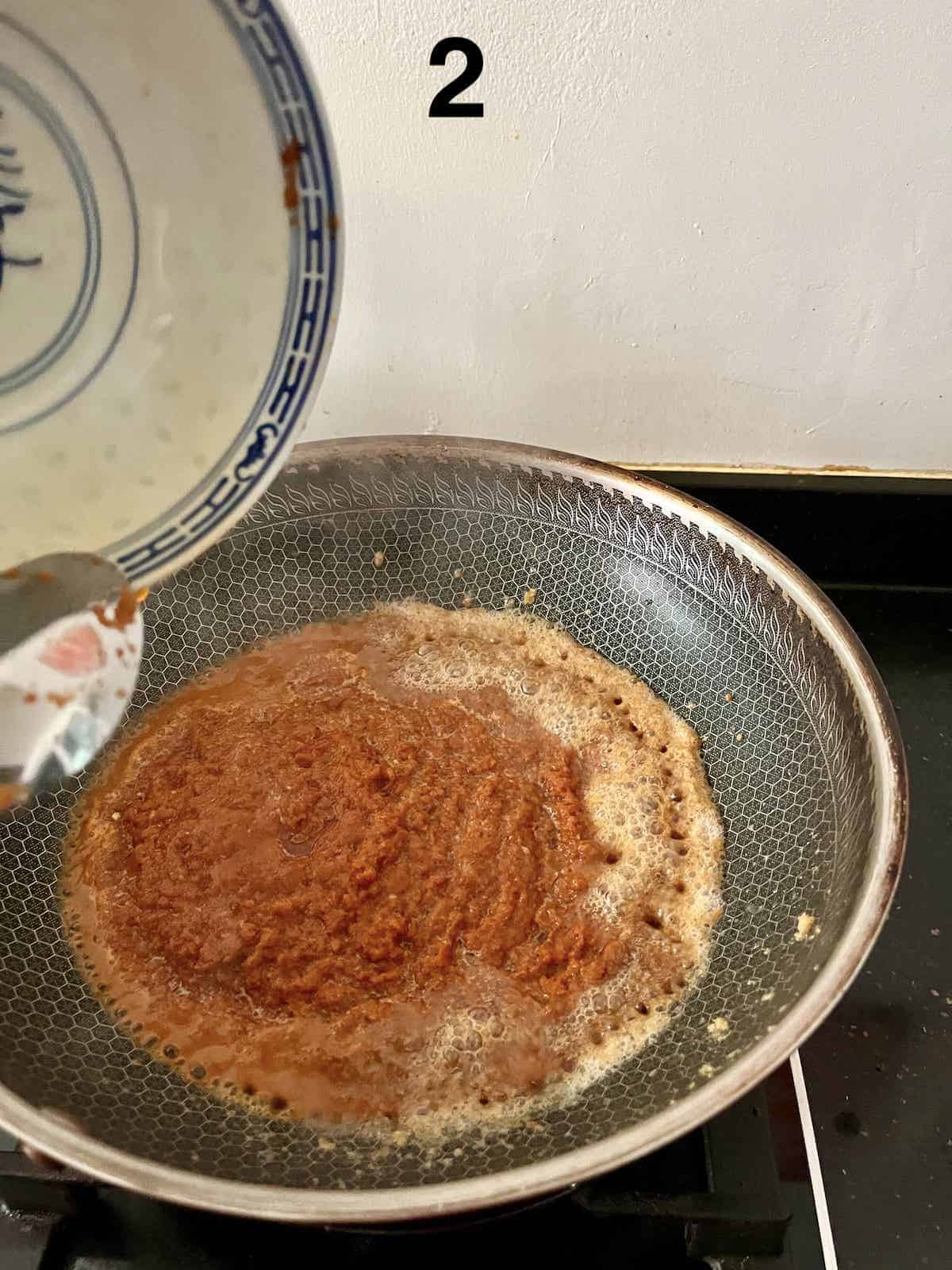
3. Pound or blend the dried prawns till they become a fine floss.
4. Add oil to the wok. Heat on medium-low till shimmering then stir-fry the pounded dried prawns for 1-2 minutes, till the smell is released.
5. Add the rempah spice paste from the previous step. Fry till fragrant and the oil has been released. (This may take a while- you'll know it's done when the paste darkens in color (see Photo 4 below for the color of the fried-till-fragrant rempah.)
6. Add salt and sugar to taste, then place the rempah in a bowl, leaving 6-8 tablespoons in the wok.
Preparing the Noodles

7. Rehydrate the bee hoon by soaking in hot water for 10-20 minutes.
Note: Some people even blanch them but I find it can make them a little brittle. If you do blanch, remember to rinse in cold water after to stop the cooking process.

8. Add water to the wok. Once simmering, add the bean sprouts (if using) and stir for about 1 minute.
9. Add in the noodles then fry over high heat and stir till all the sauce has been absorbed.
10. Lower the heat, stirring till the noodles are dry and fluffy. Plate.
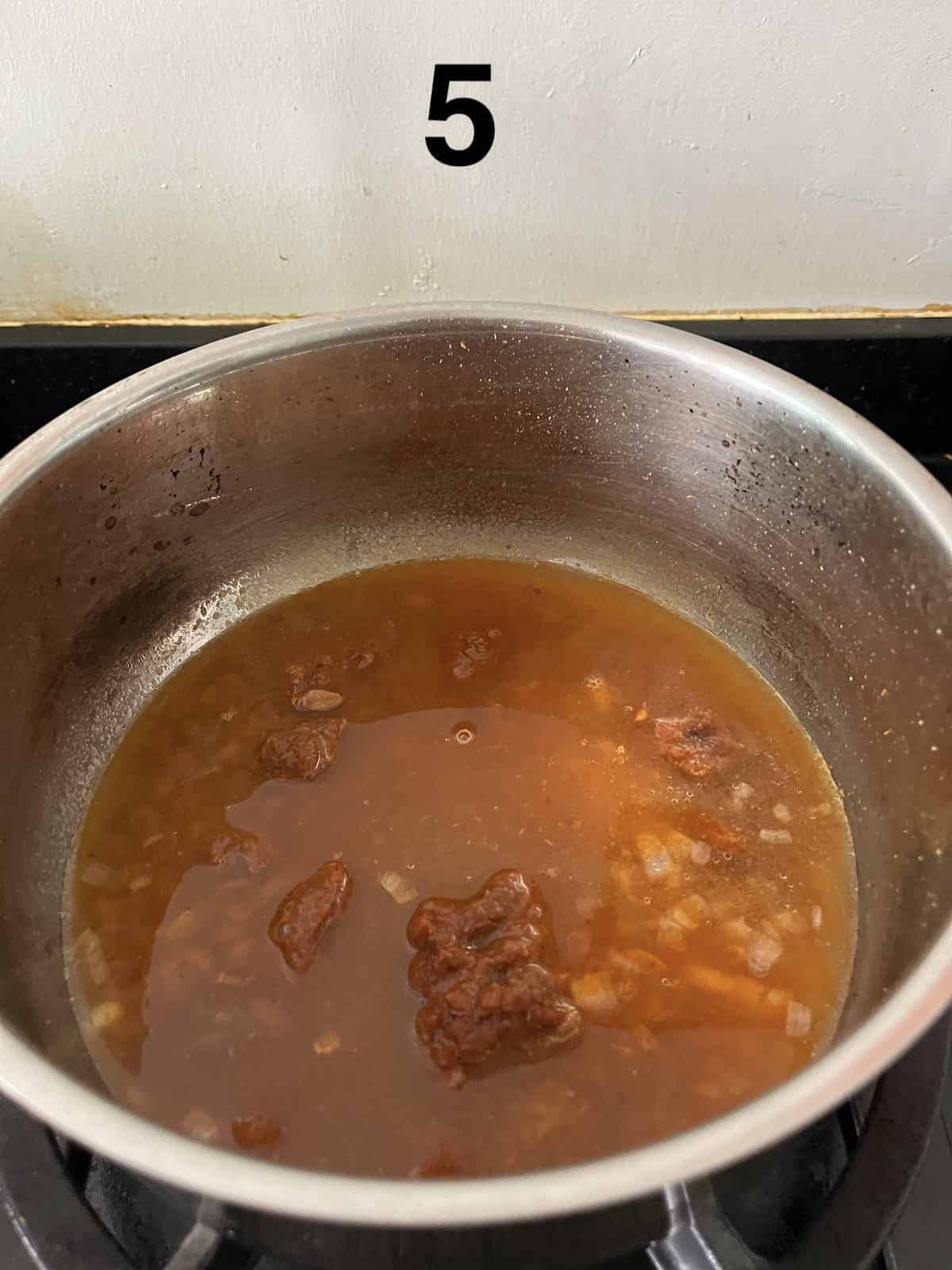
Cooking the Gravy
11. Add oil to the wok. Once shimmering, add 4.5 tablespoons of the rempah from the 1st step, the taucheo and a little tamarind water (to prevent burning). Mix well.
12. Add the rest of the tamarind water then bring to a boil.
13. Add the sugar and salt, and season to your taste.

Assembling the Noodles
14. Place some bee hoon noodles in each bowl.
15. Add a few prawns, 4-8 egg quarters and 1 halved calamansi lime to each bowl.
16. Sprinkle the Chinese koo chye, tau kwa bean curd and fried dried shrimps over each bowl.
17. Pour the gravy into the bowl then serve. Goes well with cold barley tea!
How to Store
Store the ingredients separately: i.e. the blanched vermicelli noodles in 1 container, the rempah in another, the firm tofu pieces in a 3rd etc.
When you want to eat it- this is a popular breakfast dish in Singapore, FYI!- for best results, reheat the noodles and the soup separately. Assemble after re-heating.
Expert Tips
Tip #1: If you skip stir-frying the bee hoon noodles in the spice paste before adding the gravy, the dish will be less flavorful.
Tip #2: For meal prep, I like to make the rempah spice paste in a big batch and freeze in ice cubes. These can be used to make mee siam or added to stir fries to add some oomph.
Tip #3: You can keep the water from soaking the dried prawns and blanching the shrimp as a base for soup or stews. You can freeze it if you can't use the liquid now.
Recipe FAQs
It's really up to you! In Singapore hawker centres, the dish usually does not come with meat, but I often add leftover shredded roast chicken to mine. (Don't use a roast that is very heavily flavored or it may clash with the broth.)
There is an Indian Mee Siam recipe that uses coconut milk in the gravy. It's very hard to find in Singapore now. You can try 2-3 Tablespoons of coconut milk in the gravy, or to taste.
Dishes to Serve With

Enjoyed this Singapore Mee Siam Recipe? Please leave a 5-star 🌟🌟🌟🌟🌟rating in the recipe card below & if you REALLY found it useful, a comment would make my week! Thank you and have a great day!
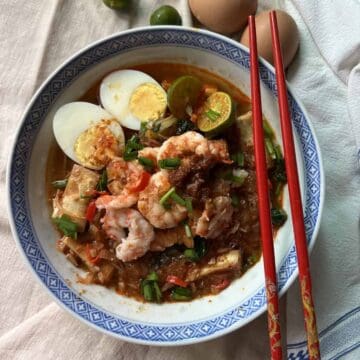
Singapore Mee Siam Recipe (with Soup)
Equipment
- mortar and pestle OR blender
- Wok (or pot)
Ingredients
A.For the wet mee siam rempah (spice paste)
- 40 Dried chillies Soaked to soften. Remove the seeds if you don't want to choke on the spice!
- 7 oz Shallots (200g) Substitute: onions, preferably red, cut into small pieces
- 0.7 0z Shrimp paste (belacan) (20g)
- 1.05 0z Candlenuts (kemiri) (30g) Substitute with macademia if you live outside of Asia and can't find this (I did manage to find it in Chinatown in London so you never know!)
- 0-5 fresh large red chillies (The number of chillies I use depends on the fertility of my chilli plant!) These are added for color so it's OK if you don't have any.
A. Pound separately
- 3 Tablespoons dried prawns, soaked till softened. Pound alone. Keep the soaking water to add to soups or stews.
- 1 teaspoon sugar or to taste
- 1 teaspoon salt or fish sauce, to taste
B. Noodles
- 4-6 Tablespoons cooking oil
- 20.25 oz water (600ml)
- 15.75 oz beansprouts (450g)
- 15.75 oz fine rice vermicelli (bee hoon) (450g) soaked in hot water till soft
- 6-8 Tablespoons rempah from above (Section A)
C. Gravy
- 1-2 Tablespoons Oil
- 4½ Tablespoons rempah from above (Section A) If you still have rempah left, freeze it or use it to stir-fry vegetables.
- 9¾ Cups water (about 2.25 litres/ 76.05 oz)
- 1½ Tablespoons tamarind (assam jawa)
- 1½ Cup water (12 oz/ 354ml) Mix with the tamarind above, then squeeze through cheesecloth and strain. Keep the water!
- 3 Tablespoons taucheo (preserved soya beans), mashed coarsely with a fork Substitute with miso or doenjang if that's what you can get
- 3 teaspoon sugar or to taste
- salt to taste
D. Ingredients and garnishing
- 8-16 hard boiled eggs, peeled and sliced into 4 Depending on whether you want 1 or 2 eggs per person
- 20.25 oz prawns (600g)
- 3 pieces tau kwa, deep fried and cut into 1 cm cubes
- 5.25 oz Chinese chives (koo chye) (150g) Use spring onions if you can't get koo chye. Wash and cut them into ½ cm bits
- 8 limes, sliced in half preferably calamansi limes
- 3 Tablespoons dried prawns Cut into small pieces then stir fried with a little oil
Instructions
A. Rempah
- Boil the dried chillies till they are soft. (Remove some or all of the seeds, if not, it'll be super spicy!) Drain then pound the chillies with the rest of the rempah ingredients (from Section A but not including the dried prawns, salt and sugar) till they've become a fine paste. (The water from boiling the chillies can be discarded.)
- Add oil to the wok and heat till shimmering then add the pounded dried prawns for 1-2 minutes, till the smell is released. Add the rempah spice paste from above and continue stir frying till fragrant and the oil has been released. (This may take a while)
- Add salt and sugar to taste, then place the rempah in a bowl, leaving 4-5 tablespoons in the wok.
B. Noodles
- Add the water to the wok. Once simmering, add the bean sprouts and stir for about 1 minute. Add in the noodles then fry over high heat and stir till all the sauce has been absorbed.
- Lower the heat, stirring continuously till the noodles are dry and fluffy. Plate.
C. Gravy
D. Assembling the noodles, gravy, ingredients and garnishing
- Boil the eggs, peel then cut into quarters.
- Boil the prawns till cooked, shell, de-vein and, if feeling hardworking (or short on ingredients but want to bulk up the plate) halve the prawns. (The water used to boil the prawns can be kept as a base for soup stock.)
- Assemble your bowls: place some bee hoon in each bowl, then pour the gravy soup over the noodles. Add a few prawns, 4-8 egg quarters and 1 calamansi (ie 2 pieces since it's sliced in half) to each bowl.
- Sprinkle the koo chye, tau kwa and fried dried shrimps over each bowl.
Notes
Note: the nutritional information is an estimate automatically calculated using the WPRM recipe maker and I am not responsible for its veracity.
Nutrition
If you've enjoyed this Singapore wet Mee Siam Soup recipe, why not try the stir-fried mee siam next? It's my favorite! Let me know what you think of it in the comments!

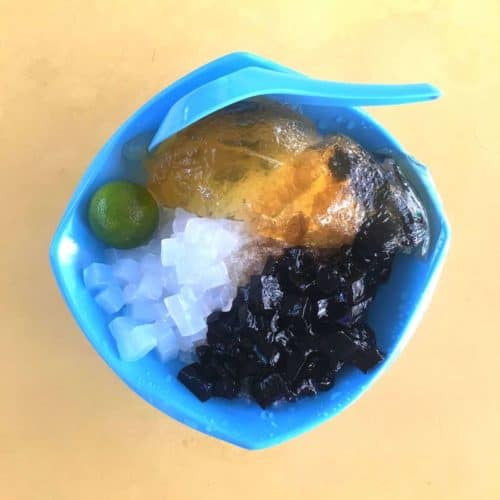






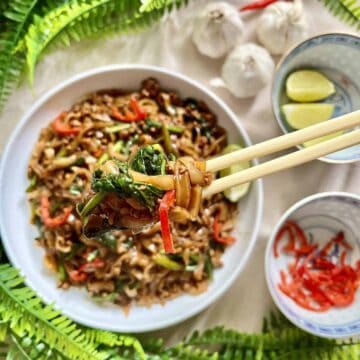
Dorene chew says
Hi: can I venture out and use “Ipoh hor fun” instead of vermecilli?
Tina says
I love this recipe! Would love to see how you cook the dried version!
Zen says
Awesome, great to hear u r a fan- working on tweaking the dried recipe as we speak!
Jeannie says
This looks great I havent tried mee siam before Im curious now!
Zen says
Thanks! if u like tangy flavours and noodles, you d probably like it! 🙂 Sadly it's not as well known as some of the other Singaporean dishes!
Gina Abernathy says
This sounds absolutely amazing and I would love to try it! Thanks for posting an interesting recipe.
Zen says
Very happy you find it interesting! Do let me know if u try it!
Cindy Mom the Lunch Lady says
Oh wow the ingredients in this recipe are so flavorful. Looks absolutely delicious!!
Zen says
Haha ya my blog is all about bold flavours, so I like flavourful ingredients 🙂
Colette says
Wow, this looks phenomenal! I love this type of food ☺️
Zen says
yay! 🙂 I should check out your channel more since we like the same type of food 🙂
Dorene cheo says
Hi, can you please do a recipe on fried bee Hoon or fried glass noodles? Thank you
Zen says
aw thanks for the interest! we eat fried bee hoon a lot actually so I'll be happy to share a recipe 🙂
Dorene cheo says
I had this dish twice in a row and thoroughly enjoyed it. Thank you. Can you , if it is possible, share a recipe with me on fried bee Hoon or fried glass noodles. Thank you
Zen says
Definitely! Will do so ASAP once I work out the measurements (usually we cook agak agak!)
Dorene cheo says
One of my favorites; my domestic helper is cooking it for my lunch ch and dinner tomorrow using your recipe; thank you
Zen says
glad u like it and want to try it!